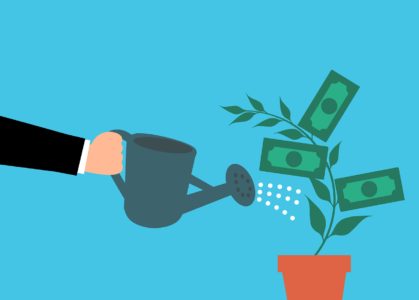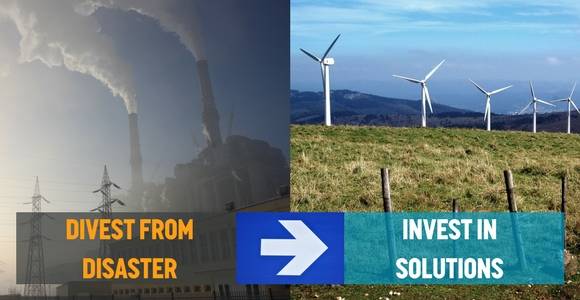By Julia Moravcsik
 In recent years it has become easy to create your own investment portfolio using online investment apps. Find out how to create a fossil-free and green tech retirement or investment portfolio that helps fight climate change and earns money in the upcoming sustainable energy revolution.
In recent years it has become easy to create your own investment portfolio using online investment apps. Find out how to create a fossil-free and green tech retirement or investment portfolio that helps fight climate change and earns money in the upcoming sustainable energy revolution.
What is Self-Directed Investing and What are the Advantages?
Once upon a time, if you wanted to invest money, you had to contact a broker who would create a portfolio for you. Times have changed, and the internet has allowed people to create their own portfolios and invest in the companies that they themselves choose. This has opened up opportunities for people to invest according to their values and vision for the future.
Creating your own portfolio is called self-directed investing, as opposed to institutional investing, which is giving your money to a broker to invest. You can do both of these at once, allowing a broker to invest some of your investment funds, while keeping some for self-directed investing. Some people have most of their money in institutional investment accounts, but use extra money from their income to invest in sustainability companies. Others choose to invest all their assets themselves.
Self-directed investing has advantages and disadvantages. The fees are substantially lower for self-directed investing. You can tailor your investments to your values and your knowledge of different industries. However, you do not have the benefit of a professional so you need to educate yourself.
How To Use Online Investment Apps
There are a number of investment apps to choose from. You can choose from apps that are entirely online investment apps or apps that are associated with a traditional bank or investment company. Online investment apps include Robinhood, Webull, E*Trade, or Ameritrade. Investment apps associated with a traditional institution include Citibank, Wells Fargo, Vanguard, and Merrill Lynch (Edge). You can find these on your phone’s app store or find their websites by googling. Some of these apps offer a few free stocks for signing up, so google to see if there are any specials or people willing to refer you for an extra stock or two. Once you decide on an app, you will set up an account, and link to your banking institution to transfer money. Once you’ve transferred money, you can start investing!
Safe and Risky Investments
 Investments can be safe or risky. As a general rule, the safe ones won’t go down as much, but they also won’t go up as much. The risky ones have the potential to make a lot of money, but also the potential to lose much or all. In general, the safest to least safe are: index funds, ETFs, established companies, new and growing companies, pre-IPO. I will describe each of these. (I will give examples of stocks, but they are just examples, not recommendations.)
Investments can be safe or risky. As a general rule, the safe ones won’t go down as much, but they also won’t go up as much. The risky ones have the potential to make a lot of money, but also the potential to lose much or all. In general, the safest to least safe are: index funds, ETFs, established companies, new and growing companies, pre-IPO. I will describe each of these. (I will give examples of stocks, but they are just examples, not recommendations.)
Index funds are the safest. They track a market index, like the S&P 500 or NASDAQ. The S&P 500 is an index of 500 leading companies. However, the problem with index funds for people who want to do fossil free investing is that some of the companies in the S&P 500 are oil companies. If you want to invest in the S&P 500 with the oil companies removed, you can choose $SPYX. (Note: The format for stocks is a dollar sign and then the stock symbol. You can google $SPYX or any other stock to see its performance.)
ETFs are the next safest. ETFs are like mutual funds. They can track a given sector or commodity, which makes them ideal for people who want to invest in green technology. You can find ETFs for electric and autonomous vehicles ($DRIV, $KARS, $HAIL), batteries for EVs or energy storage ($LIT, $REMX, $BATT), smart grids ($GRID), sustainable food and agriculture ($EATV), solar ($RAYS, $TAN), wind ($FAN), or general sustainable energy and cleantech ($CTEC, $KLNE, $QCLN, $CNRG, $ICLN).
Established Companies are the next safest. These are companies that have been around for a while and are profitable and large. Unless there is a technological disruption that makes them obsolete (like Blockbuster or Kodak) they will continue to do well. Examples of established companies in the sustainability field are Tesla ($TSLA) and SunPower $SPWR.
New Companies are next in safety level. These are companies that are not profitable or established, but might have a promising product and good management. This is where you get into more risk because these companies might not be able to survive to the point where they get profitable. New companies are using money to grow and build, but haven’t yet reached the point where the growth money equals the profit money. Examples are Rivian ($RIVN) and Local Bounti ($LOCL).
Pre-IPOs are the riskiest, but have a chance for great reward. These are companies that aren’t in the stock market yet. You can still invest in them through websites like EquityZen. The cost per “share” is usually significantly lower than when the company IPOs (enters the stock market) so you can make a lot of money. However, if the company doesn’t make it you lose all your money.
Investing For The Future: Tips & Next Steps
 One important thing to keep in mind is that investing is for the future, not the present or the past. If a company or a sector has done well in the past, this does not necessarily mean that it will do well in the future. One of the great things about sustainable, fossil-free investing is that most people agree that the future will be one of renewable energy, clean transportation, green buildings, electric farm equipment, electric landscaping equipment, and low carbon concrete. Successful companies in these areas can grow rapidly and take over sectors that are currently dominated by carbon-emitting technology.
One important thing to keep in mind is that investing is for the future, not the present or the past. If a company or a sector has done well in the past, this does not necessarily mean that it will do well in the future. One of the great things about sustainable, fossil-free investing is that most people agree that the future will be one of renewable energy, clean transportation, green buildings, electric farm equipment, electric landscaping equipment, and low carbon concrete. Successful companies in these areas can grow rapidly and take over sectors that are currently dominated by carbon-emitting technology.
Also, choose promising companies and stick with them for the future instead of buying and selling quickly. People who buy and sell quickly and impulsively usually lose money.
Watch Your Emotions The key to investing is to buy low and sell high. However, your emotions might tell you to do the exact opposite! If the market crashes or a company’s stock plummets, it feels scary to buy, because everyone else is selling and the price is sinking. But this is exactly the time when the stock is “on sale”. Similarly, if the market is high or a company’s stock has quickly reached record highs, you might feel excited and want to buy. However, this is the time when the price is the highest. In the words of Warren Buffet, “be greedy when others are fearful and fearful when others are greedy”.
Invest In What You Know If you are in the sustainability field, or know people who are, you might know things that you can leverage. For example, if you are in the battery field, you may know of a new type of battery that seems very promising. Since most people don’t know enough about batteries to know that it is promising, you can buy stock in companies with this type of battery while the price is still low.
Start Slow It is tempting to get overly excited and want to put all your money into your self-picked stocks. It’s safer, though, to start slow and learn some real life lessons before you invest all your retirement money. Do some online research, buy a few stocks, see what happens, and then buy a few more.
With online investing, you can pick stocks that support a sustainable future and squeeze out obsolete dirty technologies. You are voting with your dollar. As more and more people do this, we can make more and more of a difference and work towards a sustainable world, one stock at a time.
How Can You Take Action?
Want to get more involved with 350 Colorado’s efforts to defund the climate crisis? Join the Defund Climate Disaster/Divest-Invest Committee to receive ongoing action alerts and stay up to date with campaign planning.
- Break ties with and boycott banks financing harmful projects. Select a financial institution that is not financing fossil fuel projects and infrastructure, such as tar sands oil, fracking, coal mining, and oil or natural gas pipelines. Credit Unions are a great place to start.
- Support Public Banking! 350 Colorado, as part of the Colorado Public Banking Coalition, is continuing to call on Colorado Legislators to support legislation to establish a Colorado public bank and allow municipal governments to establish public banks. Sign on to our support letter here!
- Cut ties with insurers that insure or invest in fossil fuels. Call on your city or county to do so as well. Check out this Toolkit and learn more here.
*Please note: THIS ARTICLE IS NOT FORMAL INVESTMENT ADVICE. DO YOUR OWN RESEARCH TO DECIDE WHAT WORKS FOR YOU.
About the author: Julia is the Colorado Regional Business Director of DRIVYN, a company that provides in-person one-on-one Tesla courses. Julia also works on many sustainability projects, including being the events coordinator for the Denver Electric Vehicle Council, the head of the Automotive Business Team for Citizens Climate Lobby, the cofounder of a Boulder green home education group, attending frequent EV shows, and working for Coltura to spearhead legislation to phase out gas cars in Colorado and to give incentives for low income, high mileage drivers for EVs.
